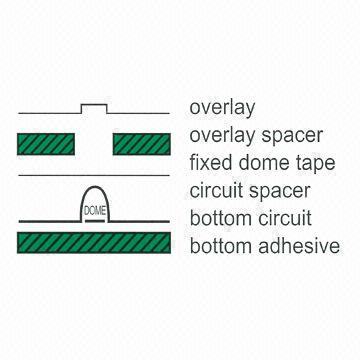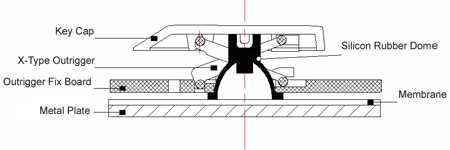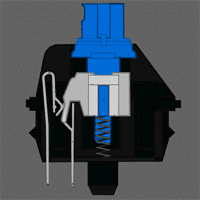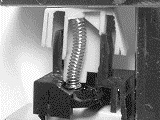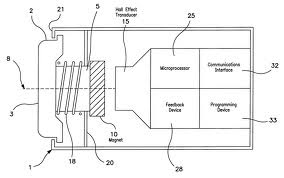Industrial Keypads Information
Industrial keypads allow users to press keys or enter codes to control equipment and machinery. Specifically, industrial keypads are manufactured to withstand the rigors of industrial processes and environments. Keypads are mainly used to enter numbers, but can be tailored for a variety of uses.

Operation
Industrial keypads can be distinguished by how the keypad's buttons are mounted, and the methodology of how the device recognizes which alphanumeric characters or symbols have been selected.
|
|
|
Image credit: Global Sources |
|
Image credit: Capacity Keyboard |
|
Image credit: Overclock |
|
Image credit: Deskthority |
|
Image credit: Deskthority |
|
Images credits: Sweet et al |
Mounting and Sizes
Most commonly, keypads are integrated into other equipment or devices for access control and data input. They may be hard- or soft-linked to computers, logic controllers, or circuits. As such, it is important to place keypads in an ergonomic and location according to the application specifications.
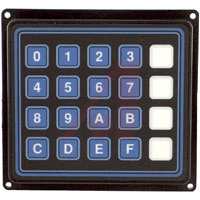 There are four standard keypad sizes:
There are four standard keypad sizes:
-
1 x 4. Such keypads typically utilize custom symbols, numerals 1-4, or four separate alphabet letters to designate input.
-
3 x 4. This is a common type of keypad found on telephones, which typically utilizes all ten single-digit numerals, as well as the number sign (#) and asterisk (*).
-
4 x 4. Often found on calculators, this keypad features all ten single-digit numerals, as well as various mathematical functions.
-
5 x 4. This type of keypad has characters and symbols that are typically specified by the end-user according to the application's input needs.
Users who require mounting styles or keypads which may require a different layout matrix should consult a keypad service.
Keypad Characters
The most common characters placed on keypad buttons include single-digit numerals--thereby allowing an endless permutation of number strings--and the alphabet of the environment's predominant language. Symbols and words may be used to represent specific functions on a key pad as well. Since keypads do not offer the input versatility of an industrial keyboard, buttons are sometimes programmed with alternate meanings.
Specifications
Electrical switch specifications for standard keypads include:
-
Maximum current rating: The maximum nominal, or name plate current capacity of a device.
-
Maximum alternating current (AC) voltage rating: The maximum AC voltage capacity of a device.
-
Maximum direct current (DC) current rating: The maximum DC voltage capacity of a device.
Standard keypads with X-Y outputs are matrix-style devices. Devices with a single pole or common bus output require the same number of pins as buttons.
Features
-
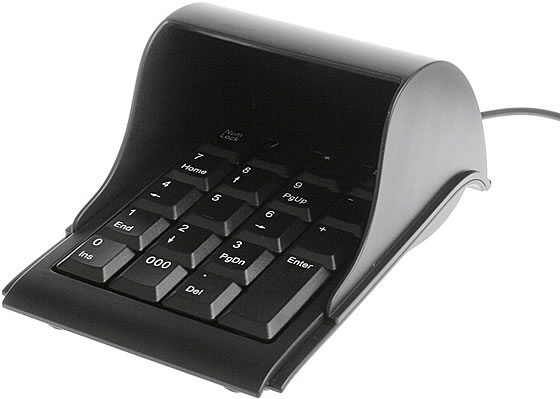 Industrial keypads are often backlit and include light-emitting diodes (LED) to indicate input recognition, process status, system functions, machine interlocks, and alarm conditions.
Industrial keypads are often backlit and include light-emitting diodes (LED) to indicate input recognition, process status, system functions, machine interlocks, and alarm conditions. -
Embossed switches have graphics or alphanumerical characters that are raised from the switch surface.
-
Switches, panels and keypads that are designed for outdoor use are water resistant or waterproof and can withstand both ultraviolet (UV) light and variations in ambient temperature.
-
Keypads in sensitive applications may require protection from electromagnetic interference, radio frequency interference, and electrostatic discharge. EMI, RF, and ESD protection ensures the device's operation is not compromised by other electrical fields or stray charges.
-
Vandal protection prevents unauthorized individuals from servicing, operating, or hacking the keypad.
-
Keypad blinders prevent nearby individuals from observing the user's input.
-
Covers are an easy way of safeguarding keypads susceptible to debris, liquids, and impacts.
Standards
The accompanying standards may be useful when considering industrial keypads, as well as their implementation.
ATIS 0700703 -- Letter allocation on keypads
CSA ISO/IEC 9995 -- Keyboard layouts for text and offices (includes keypads)
BS DD ENV 13093 -- Interface requirements for keypads on public transportation systems
DS/EN 1332-3 -- Identification card systems and keypads
Applications
Common applications for industrial keypads include automating manufacturing and industrial equipment, security access, point-of-sale and banking applications, telecommunications, vehicular controls, and display controls.
Resources
Ergo Canada — Mechanical Keyswitches, Membrane Keyswitches, Scissor-Switch Membrane Keyswitches
Make Use Of — How Does a Mechanical Keyboard Work?
Images Credits
- 1x4
- 3x4
- 4x4
- 5x4
- Backlit Options
- Conductive Rubber Overlay
- Detents / Tactile Feedback
- Dustproof
- EMI / RFI Shielding
- Front Panel
- Full Travel Keypad Buttons
- Has CE Certification
- Has CSA Certification
- Is UL listed
- Membrane Overlay
- Metallic
- Metallic
- PC Pins
- Rear Panel
- Ribbon Cable w/ Connector
- Single Pole / Common Bus
- Splashproof
- Thermoplastic / Plastic
- Thermoplastic / Plastic
- X-Y

